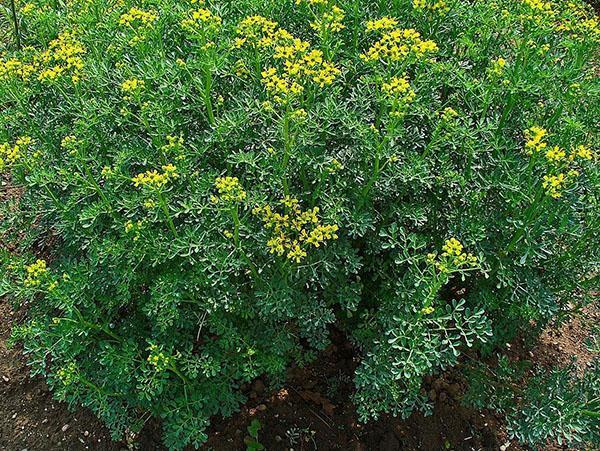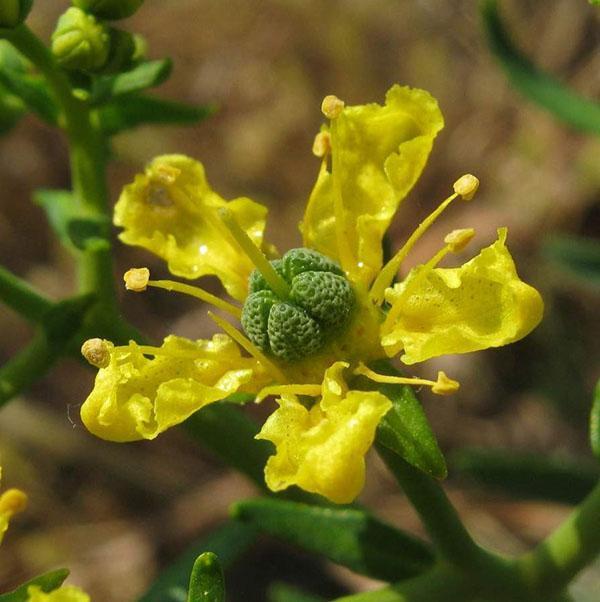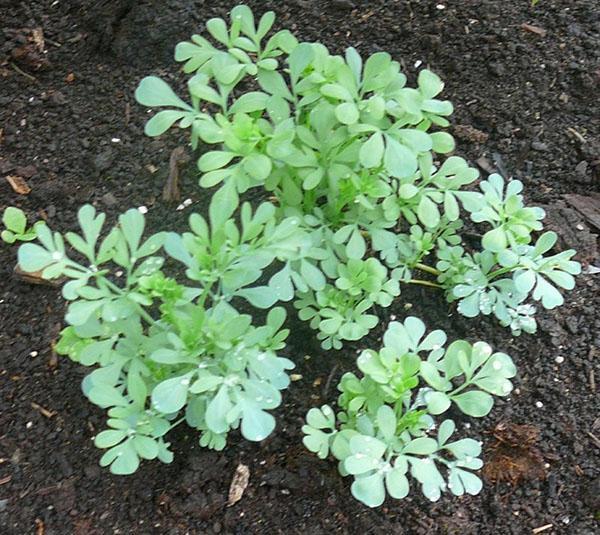Growing rue in a summer cottage
 Growing rue is becoming quite popular in gardening circles. The flower is famous not only for its original appearance, but also for its useful qualities. The plant is widely used in pharmaceuticals, culinary and alternative medicine.
Growing rue is becoming quite popular in gardening circles. The flower is famous not only for its original appearance, but also for its useful qualities. The plant is widely used in pharmaceuticals, culinary and alternative medicine.
External characteristics and use of the plant

In Rome, the plant ruta was used as a remedy against witchcraft.
Woody parts of the plant have a bright yellow tint. Leaves and shoots are green, with a slight gray tint. In summer, yellow flowers bloom on the bush. If you look closely, you can see small specks on the petals that contain essential oil.
Ruta is a long-term plant that has adapted well to our climate. With proper care, the bush will delight with its unusual appearance for about 20 years.
It is important to remember that rue must be used with great care and dosage carefully monitored. All this is due to the toxicity of the plant. Essential oils of rue are considered very useful and healing, but if you use them in large quantities, you can get skin burns.
The features of the herb are recognized in pharmacology and traditional medicine.
Ruta helps with:
- spasms and pains;
- convulsions;
- bleeding;
- remove toxins.
The plant also improves the general condition of the body, is a good antiseptic. The plant is used for menopause, atherosclerosis and neurotic disorders. Ruta also helps with migraines, epilepsy and asthenic conditions.
Growing rue: suitable soils and sites
 Ruta does not require special conditions for planting and care. The plant can be planted anywhere in the garden. The main thing to take into account is one feature - the root does not tolerate drafts. You can save the bush from the winds by natural and piece methods.
Ruta does not require special conditions for planting and care. The plant can be planted anywhere in the garden. The main thing to take into account is one feature - the root does not tolerate drafts. You can save the bush from the winds by natural and piece methods.
The plant is very often used to decorate borders. All this is due to the leaves, which have an attractive lace shape.
The most suitable for planting rue are soils that have a high percentage of lime, clay and crushed stone. The plant does not like very moist soils. Ruta develops best in higher elevations, where groundwater is far away.
In autumn, the soil is carefully dug up and fertilized humus for winter. With the onset of spring, the site is re-loosened and seedlings are planted.
The collected and dried twigs retain their healing properties for one year.
In one place, the rue can live for about six years, while not losing its attractiveness and abundance of flowering.
Planting seeds
 There should be a sufficient amount of light in the area where the root is planned to be planted. This is an important condition on which the appearance and flowering of the bush depends. In the hot period of the day, it is recommended to shade the plant, but you should not do this very often, as the leaves will turn yellow and change shape.
There should be a sufficient amount of light in the area where the root is planned to be planted. This is an important condition on which the appearance and flowering of the bush depends. In the hot period of the day, it is recommended to shade the plant, but you should not do this very often, as the leaves will turn yellow and change shape.
Initially, it is better to grow seedlings in flowerpots, and only then plant them in open ground. After the appearance of several leaves, the plants dive. It is possible to sow seeds directly into open soil, but this method will not give quick results. The first flowering will appear only after a year.
When planting the rue, it is important not to forget to leave room for the growth of bushes. It is necessary to place seedlings on the site every 60 cm.
Root breeding methods
The plant reproduces both by seeds, cuttings, and by dividing the bush.
Plant propagation by seeds
 Growing a bush from seeds is considered the most common and convenient way. When you first get to know the plant, it is better to use this particular method. If the bush is already on the site, then you can collect the seeds yourself, if not, then buy planting material in a specialized store.
Growing a bush from seeds is considered the most common and convenient way. When you first get to know the plant, it is better to use this particular method. If the bush is already on the site, then you can collect the seeds yourself, if not, then buy planting material in a specialized store.
To grow seedlings, you will need to prepare a mixture of leafy earth, sand and humus. Seeds are sown to a depth not exceeding 2 cm. You can keep seedlings both indoors and in the greenhouse, the main thing is to regularly moisten the soil. With proper care, the seeds will germinate over a period of several weeks.
It is advisable to sow plants in separate containers, but if this is not possible, then use common containers.
Seedlings are transferred to open soil in May or June, when there is no longer a threat of frost.
Propagation of rue by cuttings
 For those who are not suitable for seed propagation, cuttings are a good option.
For those who are not suitable for seed propagation, cuttings are a good option.
Initially, cuttings are prepared. Separate them from last year's shoots. This is done in early spring. Then the planting material is placed in water to speed up the rooting process. Cookware with cuttings is kept warm. It will take about four weeks for the first roots to appear. After this, the twigs should be planted in open soil for the further development of the root system.
Plant propagation by dividing the bush
 This method is no less effective. It is held in spring or late summer. To begin with, dig a bush with a pitchfork. Then they carefully divide it into several parts.
This method is no less effective. It is held in spring or late summer. To begin with, dig a bush with a pitchfork. Then they carefully divide it into several parts.
The resulting bush elements are immediately planted in pits, to the same depth at which they grew before. It is important to fertilize the bushes compost fertilizer... This will not only allow them to take root in a new place faster, but also bring the flowering process closer.
Proper care when growing rue
 The plant does not require much maintenance. The main thing that it needs is not very moist soil, a lot of sunlight and no drafts.
The plant does not require much maintenance. The main thing that it needs is not very moist soil, a lot of sunlight and no drafts.
Correct care of the root:
- Watering. The shrub withstands drought very well. It is recommended to water the plant only on very hot days, and then before or after sunset. If you oversaturate the soil with moisture, then the bush can begin to hurt and even partially die. As for spraying, it is not advisable to carry out such a procedure.
- Fertilizer. After winter, you will need to remove the spoiled branches, and fertilize the plant itself with a complex, which contains nitrogen. The next procedure is carried out in the fall. For this, it is best to use organic preparations.

- Pruning. The bush tolerates the removal of twigs quite well. Plants are pruned after winter frosts. In this case, all unhealthy and broken shoots are removed. If the rue bush is badly damaged, then it will need to be cut almost completely, leaving about twenty centimeters of the length of the branches. Using this procedure, you can give the plant a beautiful appearance, which will significantly increase its decorative properties.
If you follow all the planting conditions and properly care for the plant, then you will certainly get a beautiful and healthy plant that will decorate the site for many years. To do this, it is enough to water, cut and feed the crop correctly and on time.